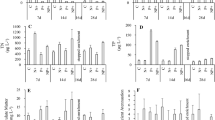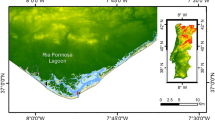Abstract
The impact of changes in nitrogen (N) and phosphorus (P) availability on the trophic strategies of planktonic protists was evaluated in a disturbed Mediterranean lagoon (Biguglia lagoon, France) using short-term bioassays. Natural communities were collected in three periods, i.e., autumn, spring and summer, to address the influence of the different environmental conditions. The responses of autotrophic plankton communities to experimentally induced N and/or P limitations were assessed as changes in chlorophyll a (Chl a) concentrations and in the abundances of potentially mixotrophic protists taxa. We observed blooms (> 105 cells l−1) of nanoflagellates in autumn, and of phycocyanin-rich picocyanobacteria in summer. Communities showed a co-limitation by N and P at the three sampling periods, despite high N:P ratios in autumn and spring. The high abundances of potentially mixotrophic dinoflagellates during these periods suggest the involvement of alternative trophic pathways for their maintenance in the lagoon. After bioassay incubations using different nutrient enrichment treatments, we often observed reduced abundances of mixotrophic protists containing Chl a with a concomitant increased abundance of protists without Chl a. This indicates a loss of chloroplasts and photoautotrophic abilities in protists cells, possibly reflecting a shift towards heterotrophy that could be sustained by phagotrophy.








Similar content being viewed by others
References
Aminot, A. & M.C. Chaussepied, 1983. Manuel des analyses chimiques en milieu marin. Brest: CNEXO.
Andersen, T., A. Schartau & E. Paasche, 1991. Quantifying external and internal nitrogen and phosphorus pools, as well as nitrogen and phosphorus supplied through remineralization, in coastal marine plankton by means of a dilution technique. Marine Ecology Progress Series 69: 67–80.
Bartón, K. & M. Mu, 2013. Multi-modal Inference. Model Selection and Model Averaging Based on Information Criteria (AICc and Alike) [available on internet at http://www.cranr-Proj].
Bates, D., M. Mächler, B. Bolker & S. Walker, 2015. Fitting linear mixed-effects models using lme4. Journal of Statistical Software. doi:https://doi.org/10.18637/jss.v067.i01.
Bellinger, E.G. & D.C. Sigee, 2015. Freshwater Algae: Identification, Enumeration and Use as Bioindicators. John Wiley, Hoboken.
Bérard-Therriault, L., M. Poulin & L. Bossé, 1999. Guide d’identification du phytoplancton marin de l’estuaire et du golfe du Saint-Laurent incluant certains protozoaires. Canadian Special Publication of Fisheries and Aquatic Sciences 128. NRC Research Press, Ottawa.
Bourrelly, P., 1990. Algues vertes : algues d’eau douce. Tome 1. Boubée.
Boesch, D.F., 2002. Challenges and opportunities for science in reducing nutrient over-enrichment of coastal ecosystems. Estuaries 25: 886–900.
Burkholder, J.M., P.M. Glibert & H.M. Skelton, 2008. Mixotrophy, a major mode of nutrition for harmful algal species in eutrophic waters. Harmful Algae 8: 77–93.
Burnham, K.P. & D.R. Anderson, 2004. Model Selection and Multimodel Inference. New York: Springer
Burson, A, M. Stomp, L. Akil, C.P.D. Brussaard & J. Huisman, 2016. Unbalanced reduction of nutrient loads has created an offshore gradient from phosphorus to nitrogen limitation in the North Sea. Limnology and Oceanography 61: 869–888.
Calbet, A & M.R. Landry, 2004. Phytoplankton growth, microzooplankton grazing, and carbon cycling in marine systems. Limnology and Oceanography 49: 51–57.
Cecchi, P., M. Garrido, Y. Collos & V. Pasqualini, 2016. Water flux management and phytoplankton communities in a Mediterranean coastal lagoon. Part II: mixotrophy of dinoflagellates as an adaptive strategy? Marine Pollution Bulletin 108: 120-133.
Chambers, J.M., 1992. Chapter 4: linear models. In: J.M. Chambers and T.J. Hastie (eds) Statistical Models in S, Wadsworth and Brooks/Cole, Belmont.
Cloern, J.E., 2001. Our evolving conceptual model of the coastal eutrophication problem. Marine Ecology Progress Series 210: 223-253
Collos, Y., B. Bec, C. Jauzein, E. Abadie, T. Laugier, J. Lautier, A. Pastoureaud, P. Souchu & A. Vaquer, 2009. Oligotrophication and emergence of picocyanobacteria and a toxic dinoflagellate in Thau Lagoon, southern France. Journal of Sea Research 61: 68–75.
Collos, Y., J. Husseini-Ratrema, B. Bec, A. Vaquer, T.L. Hoai, C. Rougier, V. Pons & P. Souchu, 2005. Pheopigment dynamics, zooplankton grazing rates and the autumnal ammonium peak in a Mediterranean lagoon. Hydrobiologia 550: 83–93
Collos, Y., A. Vaquer, B. Bibent, P. Souchu, G. Slawyk & N. Garcia, 2003. Response of coastal phytoplankton to ammonium and nitrate pulses: seasonal variations of nitrogen uptake and regeneration. Aquatic Ecology 37: 227–236.
Flynn, K.J. & A. Mitra, 2009. Building the “perfect beast”: modelling mixotrophic plankton. Journal of Plankton Research 31: 965–992.
Flynn, K.J., A Mitra, P.M. Glibert & J.M. Burkholder, 2018. Mixotrophy in harmful algal blooms: by whom, on whom, when, why, and what next. In: Glibert P.M., Berdalet E., Burford M.A., Pitcher G.C., Zhou M. (eds) Global Ecology and Oceanography. Harmful Algal Blooms, Cham: Springer: pp 113–132
Garrido, M., P. Cecchi, Y. Collos, S. Agostini & V. Pasqualini, 2016. Water flux management and phytoplankton communities in a Mediterranean coastal lagoon. Part I: how to promote dinoflagellate dominance? Marine Pollution Bulletin 104: 139–152.
Giraudoux, P., 2013. Pgirmess: data analysis in ecology. R package version 1.5.
Glibert, P.M, J.N. Boyer, C. Heil, C.J. Madden, B. Sturgis & C.S. Wazniak, 2010. Coastal Lagoons: Critical Habitats of Environmental Change. CRC Press, Boca Raton
Harpole, W.S., J.T. Ngai, E.E. Cleland, E.W. Seabloom, E.T. Borer, M.E.S. Bracken, J.J. Elser, D.S. Gruner, H. Hillebrand, J.B. Shurin & J.E. Smith, 2011. Nutrient co-limitation of primary producer communities. Ecology Letters 14: 852–862.
Johnson, M.D., 2015. Inducible Mixotrophy in the Dinoflagellate Prorocentrum minimum. Journal of Eukaryotic Microbiology 62: 431–443
Lafabrie, C., M. Garrido, C. Leboulanger, P. Cecchi, G. Grégori, V. Pasqualini & O. Pringault, 2013. Impact of contaminated-sediment resuspension on phytoplankton in the Biguglia lagoon (Corsica, Mediterranean Sea). Estuarine Coastal and Shelf Sciences 130: 70–80.
Landry, M.R., S.L. Brown, L. Campbell, J. Constantinou & H. Liu, 1998. Spatial patterns in phytoplankton growth and microzooplankton grazing in the Arabian Sea during monsoon forcing. Deep-Sea Research Part II 45: 2353–2368.
Leles, S.G., L. Polimene, J. Bruggeman, J. Blackford, S. Ciavatta, A. Mitra & K.J. Flynn, 2018. Modelling mixotrophic functional diversity and implications for ecosystem function. Journal of Plankton Research 40(6): 627–642.
Leruste, A, N. Malet, D. Munaron, V. Derolez, E. Hatey, Y. Collos, R. De Wit & B. Bec, 2016. First steps of ecological restoration in Mediterranean lagoons: shifts in phytoplankton communities. Estuarine Coastal and Shelf Sciences 180: 190–203.
Leruste, A., S. Villéger, N. Malet, R. De Wit & B. Bec, 2018. Complementarity of the multidimensional functional and the taxonomic approaches to study phytoplankton communities in three Mediterranean coastal lagoons of different trophic status. Hydrobiologia 815: 207-227.
Leruste, A., F. Guilhaumon, R. De Wit, N. Malet, Y. Collos & B. Bec, 2019a. Phytoplankton strategies to exploit nutrients in coastal lagoons with different eutrophication status and involved in a re-oligotrophication process. Aquatic Microbial Ecology 83: 131–146.
Leruste, A, V. Pasqualini, M. Garrido, N. Malet, R. De Wit & B. Bec, 2019b. Physiological and behavioral responses of phytoplankton communities to nutrient availability in a disturbed Mediterranean coastal lagoon. Estuarine, Coastal and Shelf Science 219: 176–188.
Loir, M., 2004. Guide des diatomées : Plus de 200 micro-algues silicieuses photographiées. Delachaux and Niestlé, Paris.
Millette, N.C., J.J. Pierson, A. Aceves & D.K. Stoecker, 2017. Mixotrophy in Heterocapsa rotundata: a mechanism for dominating the winter phytoplankton. Limnology and Oceanography 62: 836–845.
Mitra, A., K.J. Flynn, U. Tillmann, J.A. Raven, D. Caron, D.K. Stoecker, F. Not, P.J. Hansen, G. Hallegraeff, R. Sanders, S. Wilken, G. McManus, M. Johnson, P. Pitta, S. Våge, T. Berge, A. Calbet, F. Thingstad, H.J. Jeong, J. Burkholder, P.M. Glibert, E. Graneli & V. Lundgren, 2016. Defining planktonic protist functional groups on mechanisms for energy and nutrient acquisition: incorporation of diverse mixotrophic strategies. Protist 167: 106–120.
Mouillot, D., A. Titeux, C. Migon, V. Sandroni, J.P. Frodello & D. Viale, 2000. Anthropogenic influences on a Mediterranean Nature Reserve: modelling and forecasting. Environmental Modelling and Assessment 5: 185–192.
Neveux J. & F. Lantoine, 1993. Spectrofluorometric assay of chlorophylls and phaeopigments using the least squares approximation technique. Deep Sea Research Part I 40: 1747–1765.
Orsoni, V., P. Souchu & D. Sauzade, 2001. Caractérisation de l’état d’eutrophisation des trois principaux étangs corses (Biguglia, Diana et Urbino), et proposition de renforcement de leur surveillance. Rapport final, Ifremer.
Paerl, H.W., N.S. Hall, B.L. Peierls & K.L. Rossignol, 2014. Evolving paradigms and challenges in estuarine and coastal eutrophication dynamics in a culturally and climatically stressed world. Estuaries and Coasts 37: 243–258.
Pasqualini, V., V. Derolez, M. Garrido, V. Orsoni, Y. Baldi, S. Etourneau, V. Leoni, P. Rébillout, T. Laugier, P. Souchu & N. Malet, 2017. Spatiotemporal dynamics of submerged macrophyte status and watershed exploitation in a Mediterranean coastal lagoon: understanding critical factors in ecosystem degradation and restoration. Ecological Engineering 102: 1–14.
R Core Team, 2013. A Language and Environment for Statistical Computing. R Foundation for Statistical Computing, Vienna [available on internet in March 2019 at http://www.R-project.org/].
Reynolds, C.S., 2006. Ecology of Phytoplankton. Cambridge: Cambridge University Press.
Schramm, W., 1999. Factors influencing seaweed responses to eutrophication: some results from EU-project EUMAC. Journal of Applied Phycology 11: 69–78.
Seoane, S., M. Garmendia, M. Revilla, A. Borja, J. Franco, E. Orive & V. Valencia, 2011. Phytoplankton pigments and epifluorescence microscopy as tools for ecological status assessment in coastal and estuarine waters, within the Water Framework Directive. Marine Pollution Bulletin 62: 1484–1497.
Śliwińska-Wilczewska, S., J. Maculewicz, A. Barreiro Felpeto & A. Latała, 2018. Allelopathic and bloom-forming picocyanobacteria in a changing world. Toxins 10(1): 48.
Souchu, P., B. Bec, V.H. Smith, T. Laugier, A. Fiandrino, L. Benau, V. Orsoni, Y. Collos, & A. Vaquer, 2010. Patterns in nutrient limitation and chlorophyll a along an anthropogenic eutrophication gradient in French Mediterranean coastal lagoons. Canadian Journal of Fish Aquatic Sciences 67: 743–753.
Stoecker, D.K., 1999. Mixotrophy among dinoflagellates. Journal of Eukaryotic Microbiology 46: 397–401.
Tomas, C.R., 1997a. Identifying marine diatoms and dinoflagellates. Marine Geology 3–4: 320–321.
Tomas, C.R., 1997b. Identifying Marine Phytoplankton. Academic, Cambridge.
Utermöhl, H., 1958. Zur Vervollkommnung der quantitativen Phytoplankton-Methodik. Mitteilungen Internationale Vereinigung fuer Theoretische und Angewandte Limnologie 9: 1–38.
Willey, R.L., P.L. Walne, P. Kivic & D.J. Patterson, 1988. Phagotrophy and the origins of the euglenoid flagellates. Critical Reviews in Plant Sciences 7: 303–340.
Yamamoto, T., 2003. The Seto Inland Sea – eutrophic or oligotrophic? Marine Pollution Bulletin 47: 37–42.
Acknowledgements
Amandine Leruste was supported in 2018 by a Postdoctoral Fellowship of the University of Corsica Pasquale Paoli (SPE CNRS 6134 Laboratory and UMS Stella Mare) and the Collectivity of Corsica, and from 2013 to 2016 by a PhD Fellowship of the Doctoral School at the University of Montpellier. This work has been financed by Biguglia Lagoon Nature Reserve, the Collectivity of Corsica and the University of Corsica Pasquale Paoli, the authors are grateful for their cooperation. This work was (co)funded by the Labex DRIIHM, French Programme “Investissements d’Avenir” (ANR-11-LABX-0010) which is managed by the ANR. We thank the Ifremer Station of Bastia and the UMS Stella Mare for technical support and help during the experiments. Thanks are extended to everyone who participated in the experiments. The authors also thank the Microbex platform of the MARBEC UMR that provided microscopy and imaging equipment, and particularly Cécile Roques that provided technical support for microscopic analyses. All authors have approved the final article.
Author information
Authors and Affiliations
Corresponding author
Additional information
Handling editor: Jörg Dutz
Publisher's Note
Springer Nature remains neutral with regard to jurisdictional claims in published maps and institutional affiliations.
Rights and permissions
About this article
Cite this article
Leruste, A., Garrido, M., Malet, N. et al. Impact of nutrient availability on the trophic strategies of the planktonic protist communities in a disturbed Mediterranean coastal lagoon. Hydrobiologia 848, 1101–1119 (2021). https://doi.org/10.1007/s10750-021-04517-w
Received:
Revised:
Accepted:
Published:
Issue Date:
DOI: https://doi.org/10.1007/s10750-021-04517-w




